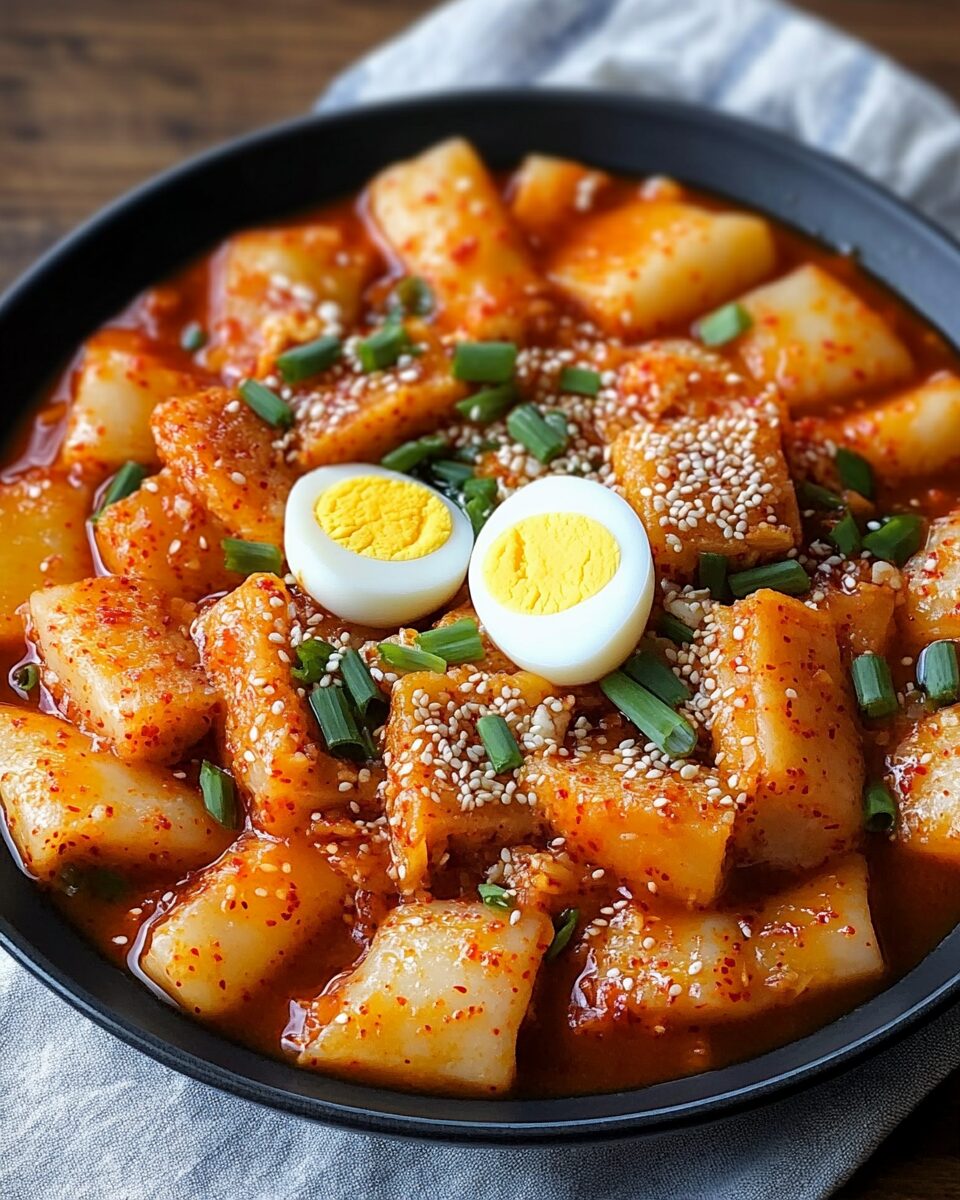Tteokbokki is a beloved Korean street food that combines chewy rice cakes with a luscious, spicy-sweet sauce made from gochujang and chili flakes. This dish delivers a perfect balance of heat, sweetness, and savory depth, making it an addictive comfort food for any season.
Beyond its bold flavors, Tteokbokki is incredibly versatile. You can easily customize it by adding fish cakes, boiled eggs, or vegetables to enhance texture and nutrition. Whether enjoyed as a quick snack or a casual meal, this fiery dish brings a taste of Korea’s vibrant street food culture right to your kitchen.
Full Recipe:
-
1 pound Korean rice cakes (tteok)
-
4 cups water or anchovy broth
-
2 tablespoons gochujang (Korean red chili paste)
-
1 tablespoon gochugaru (Korean chili flakes)
-
1 tablespoon soy sauce
-
1 tablespoon sugar
-
2 cloves garlic, minced
-
1/2 medium onion, sliced
-
1 green onion, chopped
-
1 hard-boiled egg (optional)
-
1 teaspoon toasted sesame seeds
-
1 teaspoon sesame oil
-
Fish cakes (optional), sliced
Directions:
-
If using refrigerated or frozen rice cakes, soak them in warm water for about 10 minutes to soften. Drain before cooking.
-
In a large pan, bring water or anchovy broth to a boil over medium-high heat.
-
Stir in gochujang, gochugaru, soy sauce, sugar, and minced garlic until the sauce is smooth and well combined.
-
Add the rice cakes and onions to the pan, simmer gently while stirring occasionally. Cook for about 8–10 minutes until the rice cakes become soft and chewy.
-
If using, add sliced fish cakes halfway through cooking for extra flavor and texture.
-
Once the sauce thickens and the rice cakes are tender, stir in chopped green onions and drizzle with sesame oil.
-
Serve hot, garnished with toasted sesame seeds and optional hard-boiled egg halves.
Prep Time: 10 minutes | Cooking Time: 15 minutes | Total Time: 25 minutes
Kcal: Approximately 350 kcal per serving | Servings: 4 servings
Introduction to Tteokbokki: Korea’s Beloved Street Food
Tteokbokki, often called spicy Korean rice cakes, is one of the most popular and iconic street foods in South Korea. Known for its chewy texture and bold, spicy-sweet flavors, this dish has captured the hearts of locals and food lovers worldwide. Its roots go back several centuries, originally served in royal courts before evolving into the affordable, accessible comfort food enjoyed today.
The dish primarily features cylindrical rice cakes called tteok cooked in a vibrant red sauce made from gochujang (Korean chili paste), which gives it its signature heat and flavor depth. The balance of spicy, sweet, and savory notes combined with the unique chewiness of the rice cakes makes Tteokbokki a one-of-a-kind experience that defines Korean street food culture.
Cultural Significance and Popularity
Tteokbokki has a rich cultural significance in Korea. It is more than just a snack — it is a social food often shared among friends and family in casual settings. Street vendors selling Tteokbokki line busy city streets, markets, and university campuses, offering affordable bites that warm both body and soul.
The dish’s popularity extends beyond Korea, becoming a staple in Korean restaurants internationally. Food enthusiasts appreciate its approachable spiciness and comforting texture, making it a favorite for adventurous eaters and those new to Korean cuisine alike. Tteokbokki is also frequently featured in Korean dramas and variety shows, further boosting its global recognition.
Flavor Profile and Key Ingredients
What sets Tteokbokki apart is its distinctive flavor profile, which comes primarily from gochujang and gochugaru (Korean chili flakes). These ingredients provide a deep, complex heat that is spicy but balanced by sweetness and umami. The addition of soy sauce and sugar helps round out the sauce, creating a harmony of savory and sweet.
The chewy rice cakes (tteok) themselves are made from glutinous rice flour, which gives them their soft but resilient texture. When simmered in the sauce, they absorb the flavors beautifully without losing their firmness. This contrast of tender yet chewy rice cakes coated in a luscious, thick sauce is what makes the dish so satisfying.
Additional ingredients like fish cakes, boiled eggs, and scallions add layers of texture and taste. Fish cakes introduce a mild savory element and additional chewiness, while eggs mellow out the spiciness and provide a creamy counterpoint. Scallions and toasted sesame seeds enhance the aroma and provide fresh, nutty notes.
Variations and Regional Differences
Though the classic spicy Tteokbokki is the most well-known, this dish has countless regional and creative variations across Korea. Some versions lean toward a milder taste by reducing the chili paste or incorporating creamier elements like cheese. Others might add seafood, such as squid or mussels, for a coastal twist.
There is also a popular non-spicy variety called Gungjung Tteokbokki (royal court rice cakes), which is stir-fried with soy sauce, vegetables, and beef, reflecting its aristocratic origins. Modern food culture has inspired fusion recipes, such as Tteokbokki pizza or Tteokbokki carbonara, which blend Korean flavors with Western dishes.
How to Enjoy Tteokbokki
Tteokbokki is typically enjoyed as a snack or light meal, especially in casual street food stalls or pojangmacha (tent food stalls). It pairs well with Korean fried chicken, hotteok (sweet pancakes), or a cold soft drink to balance the spiciness.
The dish is often shared, making it a social dining experience perfect for gatherings with friends or family. The chewy rice cakes invite slow, mindful eating, savoring every bite of the rich, spicy sauce.
At home, it’s an easy-to-make comfort food that can be prepared quickly, making it ideal for weeknight dinners or quick lunch options. Many home cooks customize the recipe based on their spice tolerance or preferred ingredients, adding vegetables or proteins as they like.
Nutritional Aspects and Considerations
While Tteokbokki is undeniably delicious, it is important to be mindful of its nutritional content, especially the calorie and sodium levels. The rice cakes are carbohydrate-rich, providing quick energy but not much fiber or protein on their own. The sauce, with its sugar and sodium content from soy sauce and gochujang, can also add up.
To create a more balanced meal, consider pairing Tteokbokki with protein sources like boiled eggs or fish cakes and adding vegetables such as cabbage, carrots, or green onions. These additions increase the fiber, vitamins, and minerals while complementing the dish’s flavors.
For those watching spice levels, reducing or omitting the chili flakes can make the dish more approachable without sacrificing its signature taste.
Cooking Tips for Perfect Tteokbokki
Making Tteokbokki at home can seem intimidating if you’re unfamiliar with Korean ingredients, but it is quite straightforward with a few key tips:
-
Rice Cake Preparation: If using refrigerated or frozen rice cakes, soaking them in warm water before cooking helps soften them and prevents toughness. Fresh rice cakes do not require this step.
-
Balancing the Sauce: The key to a great Tteokbokki sauce is balancing heat, sweetness, and umami. Taste and adjust sugar or chili paste amounts gradually to suit your palate.
-
Simmer Gently: Rice cakes need gentle simmering rather than boiling to soften evenly without becoming mushy. Stir frequently to prevent sticking.
-
Customize Add-ins: Feel free to add fish cakes, eggs, or vegetables halfway through cooking. These additions bring different textures and flavors, making the dish more satisfying.
Serving Suggestions and Presentation
Tteokbokki is traditionally served hot and fresh, straight from the pan or pot. The bright red sauce coated over the white, chewy rice cakes is visually striking and appetizing.
Garnishing with chopped green onions and a sprinkle of toasted sesame seeds adds freshness and a subtle crunch. Some like to drizzle a little sesame oil at the end for fragrance.
For special occasions or sharing, Tteokbokki can be plated in a shallow bowl or on a large serving dish to highlight its vibrant colors. Accompanying side dishes such as kimchi, pickled radish, or steamed vegetables help balance the meal.
Global Influence and Popularity
Thanks to the global rise of Korean culture—through K-pop, K-dramas, and Korean cuisine—Tteokbokki has transcended its street food origins and found a place on menus worldwide. Many international chefs and food enthusiasts are experimenting with it, adapting the recipe to local tastes and ingredient availability.
Its universal appeal lies in its comforting textures and exciting flavors that intrigue and satisfy diverse palates. Tteokbokki has become a gateway dish for many to explore Korean cuisine more deeply.
Conclusion: Why Tteokbokki Is a Must-Try Dish
Spicy Korean Rice Cakes, or Tteokbokki, are more than just a popular street food—they are a cultural icon and a culinary adventure packed with flavor, texture, and history. The combination of chewy rice cakes and rich, spicy-sweet sauce makes for an unforgettable eating experience.
Whether enjoyed on a bustling Korean street corner or cooked in your kitchen at home, Tteokbokki invites you to explore Korea’s vibrant food culture and embrace the joy of bold, comforting flavors. Its adaptability, satisfying texture, and striking appearance make it a dish worth trying again and again.
If you love spicy, hearty dishes that bring people together, Tteokbokki is a delicious addition to your recipe repertoire. Dive in, share with friends, and savor every bite of this timeless Korean favorite.






